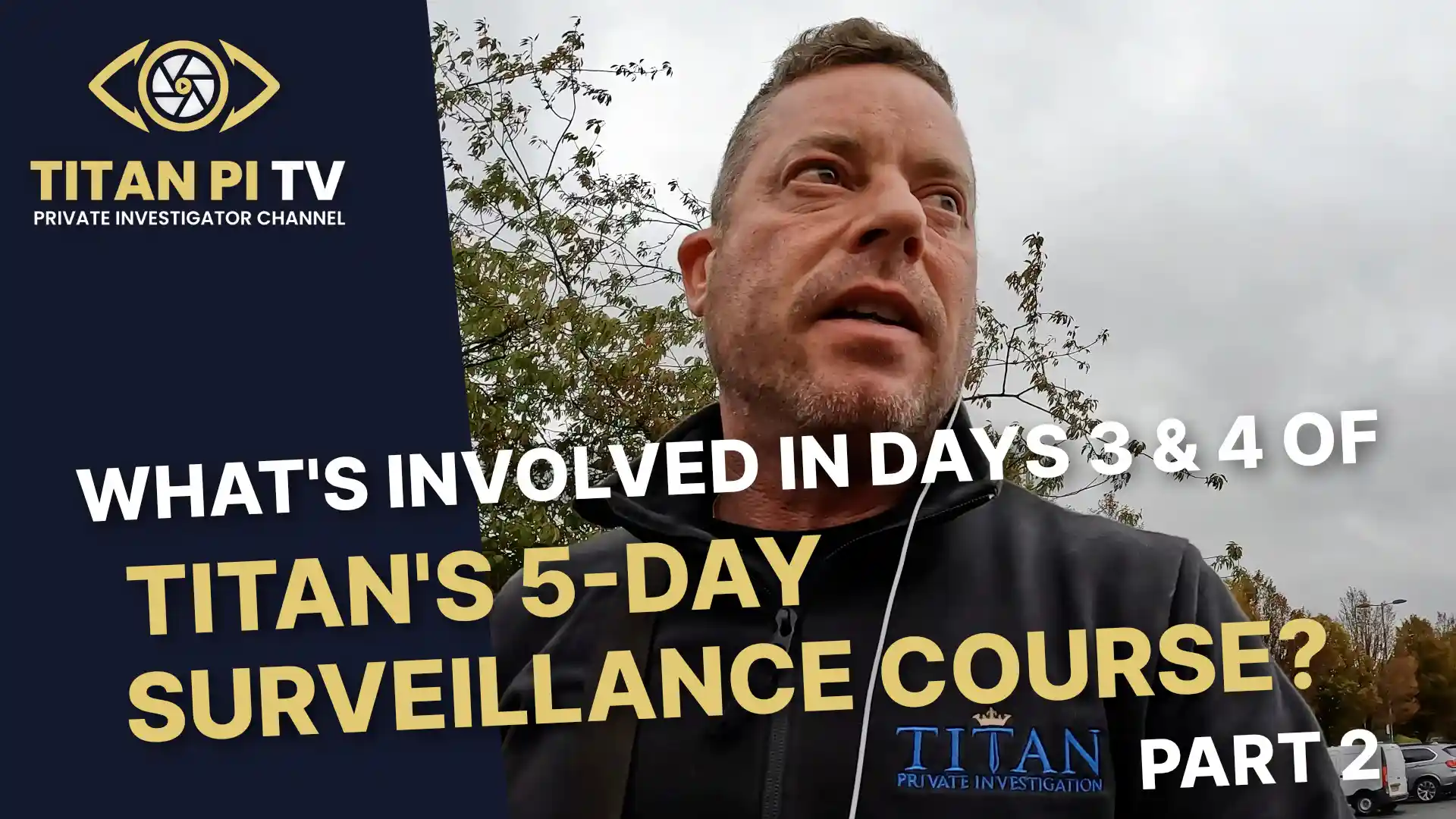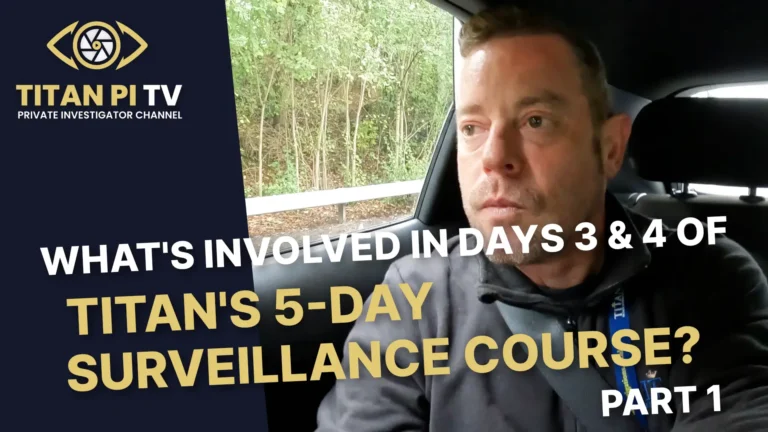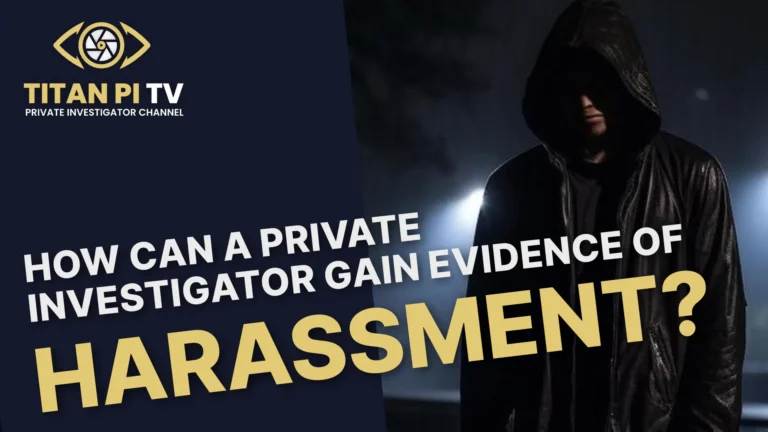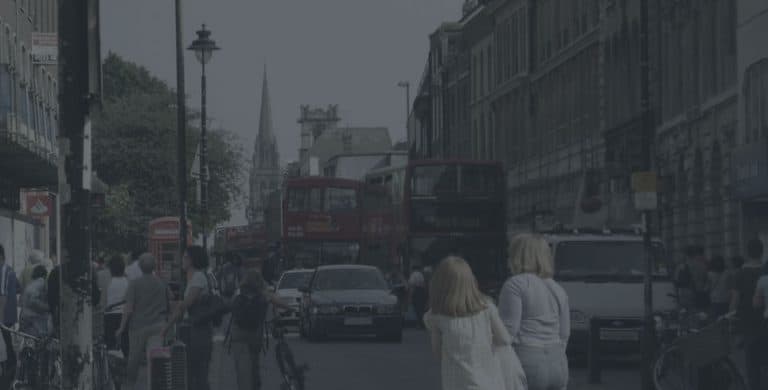A deep dive into Days 3 and 4 of Titan’s 5‑Day Surveillance Course? Part 2
Titan’s renowned industry leading surveillance training course
Professional surveillance is as much about discipline and procedure as it is about instinct and adrenaline. Imagine chasing a target through city streets at breakneck speeds, all while keeping your team invisible and your evidence rock-solid. That’s the thrill of mobile surveillance—and it’s where things truly heat up in professional PI training. Days 3 and 4 of Titan Private Investigation Ltd’s five-day surveillance course are where students transition from foundational foot work to high-tempo vehicular operations in live environments. The course, which supports an RQF Level 4 qualification in covert surveillance—sitting just above A-level standard—compresses industry-grade tradecraft into an intensive, practical programme. Whether candidates opt to pursue the formal certification or not, the core lessons remain the same: the move to mobile operations ramps up the pace, demands decisive action, and requires a meticulous eye to track subjects without a slip.
The mid-point of the course marks a shift in mindset. No longer are students merely observing; they’re now manoeuvring, coordinating, and applying procedures under pressure. It’s about turning theory into instinct, and instinct into repeatable, reliable performance in the field.
Day Three Intensives: Mobile Surveillance and Loss Prevention
Day three marks the start of advanced mobile surveillance, where vehicle-based tracking becomes the focus. Learners move from the measured pace of foot surveillance—practised on the earlier days—into the fast, dynamic reality of following a subject on the road. The British weather may occasionally be unkind, but the energy and focus remain high as teams form up in four vehicles, typically with three learners per car and one seasoned instructor guiding the operation.
Mobile Surveillance Tactics and Execution
The day begins with refined instruction on vehicular tactics: time-on-target versus team protection, staggered tailing, cover vehicles, and the art of blending into traffic without drawing attention. Students learn the importance of stacking vehicles across positions—eyeball, secondary, tertiary—while making sure no single car stays on the subject for too long. This rotation prevents pattern recognition and helps avoid detection.
The tempo is noticeably higher than foot work. Decisions must be made in seconds, with constant updates over comms: position reports, traffic commentary, last-known visual calls, and ahead planning for likely turn-offs or choke points. The concept of “anticipation” is drilled repeatedly—teams learn to plan one or two moves ahead, to pre-empt the subject’s options, and to position assets accordingly.
For hours, four vehicles weave through Derby’s streets and surrounding areas, practising handovers like a relay team. A clean handover is a signature sign of a competent unit: seamless, concise, and invisible to the subject. By the time the team returns around 5pm, they’re physically tired but notably sharper. That 11-hour push is not incidental; it builds stamina and concentration for real-world deployments where operations can run long, and performance cannot dip.
Mastering Stop and Plot Procedures
When the subject halts—at a shop, a takeaway, a GP practice, or a workplace—the team initiates a “stop and plot”. This is a controlled containment move: the immediate vicinity is mapped, vehicles and observers position to cover all plausible pedestrian and vehicular exits, and a sterile zone is maintained so no team car is seen loitering directly on the target.
The principle is simple: create a clean, monitored bubble without contaminating it. One team member typically takes point, confirming the stop location, the subject’s activity (if observable), and any risk factors such as CCTV coverage, private security, or limited access areas. The others adopt overwatch positions and ready themselves for a good “lift” when the subject moves again. Done correctly, stop and plot removes gaps, cuts down the risk of early loss, and keeps the operation tight and controlled.
The “HELP” Protocol for Loss Recovery
Losses can happen even to skilled operators. What separates professionals from amateurs is how fast and how effectively they recover. Titan drills the HELP mnemonic for loss recovery, a practical anchor when adrenaline spikes:
- Honesty: Declare the loss the moment it happens—no ego, no delay.
- Early: Make the call immediately to maximise recovery time.
- Location: Provide the last-known position, direction of travel, and context.
- Procedure: Follow the team’s pre-briefed recovery drills precisely.
Instructors emphasise that when HELP is executed in full, recovery rates approach 100%. Skip any part—particularly the early call—and recovery odds drop dramatically. This turns panic into plan and reminds learners that surveillance is a team sport. The goal is not to hide a mistake, but to rescue the operation.
By evening, students move into anti-surveillance (AS) awareness and static ops fundamentals. They learn to recognise when they themselves are being observed or tested, and how to set up fixed watches without contamination. Homework typically involves reviewing procedures and imagery standards, cementing the day’s lessons.
Day Four Focus: High-Speed Environments and Image Integrity
Day four escalates the complexity. Now the terrain includes motorways and complex venues like multi-storey car parks. The morning covers advanced theory and terminology, before the cohort goes straight back into the field. Speeds climb, and so do the stakes—one poor decision can instantly contaminate evidence, alert a subject, or jeopardise safety.
Navigating Motorway Surveillance and Glossary
Motorway surveillance is a different beast. At 70 mph, everything compresses: decision windows are shorter, exits come up quickly, and spacing is crucial. The specialised lingo helps cut through radio clutter. The “eyeball” vehicle holds the live visual; the secondary and tertiary positions manage spacing, anticipate exits, and prepare to take the eyeball on call. The convoy performs “yo-yo” tactics: the eyeball drops back and another vehicle runs through to take position, maintaining a fluid, non-patterned tail.
In training, subjects may be capped at 60 mph, but the convoy often works at 70–75 mph to maintain safe spacing and control the handover timing. This is not about racing; it’s about rhythm, timing, and reading traffic to make switches cleanly. Handover drills are rehearsed and repeated until they’re instinctive. A quick “plot” call primes the team for upcoming junctions, merges, or service areas.
The glossary isn’t academic—it is mission-critical. Shared language keeps stress down and precision up, particularly as teams negotiate roundabouts with multiple exits, filter lanes, and sudden manoeuvres from the subject.
Specialised Venue Procedures: Multi-Storey Car Parks
Multi-storey car parks represent a unique operational challenge. Echoing concrete, tight turning radii, blind ramps, limited lines of sight, and CCTV coverage all conspire to expose careless surveillance. Titan trains specific entry tactics: staggering arrivals, avoiding bunching, and selecting levels that offer both vantage and discretion. The aim is to locate the subject’s vehicle swiftly, determine likely exit routes, and coordinate a subtle box without sitting obviously on top of the target.
Subtlety is vital: tyres squealing or doors slamming can spook a subject, and an incorrect lane choice on exit can leave the team exposed or create a gap the subject can exploit. Patience, planning, and quiet confidence are essential. Instructors share real-world pitfalls—like reflective surfaces or glass balustrades giving away observers—and teach students to adapt.
Imagery: The Ultimate Measure of Professionalism
You can execute perfect tail craft, but if your imagery is poor, your deliverable is compromised. Clients buy proof: clear, time-stamped photographs and video that stand up to scrutiny. On Titan’s course, imagery standards are non-negotiable. Date and time stamps, consistent focus, and contextual frames form the backbone of professional reporting.
Equipment choices matter. While modern phones are powerful, they are often insufficient in dynamic surveillance. Learners are introduced to stabilised platforms, discrete mounts, and techniques for avoiding dashboard glare or reflective contamination. Wide angles capture context; tighter crops capture identity. Both are needed. Noisy, shaky footage screams amateurism. Clean, well-framed imagery builds trust and underpins case outcomes—particularly in civil proceedings, HR investigations, or insurance matters where evidence integrity is paramount.
Practical tips abound: pre-setting exposure for car parks, using external mounts judiciously, understanding the difference between evidential frames and narrative frames, and always documenting sequences so that a third party can follow the story without ambiguity.
Integrated Practical Application: From Theory to Live Exercise
Day four’s learning is not left in the classroom. Students are quickly briefed into a live training scenario and deployed. The subject is known to frequent a Starbucks—an ideal beginning for a clean “lift”. Foot units are staged discreetly inside and nearby, while vehicles hold positions to provide a sterile zone around possible exits.
Real-Time Application of Motorway Tactics
The subject’s car is parked behind a BP garage. Foot teams confirm the position and activity. Alpha 4 takes the initial eyeball as the subject departs, slipping onto a busy roundabout with five exits. Alpha 2 and 3 plot the sterile zone and prepare for a handover. Once mobile, the convoy aims northbound on the M1 from Junction 25. This is where the nuance shows: spacing, patience, overtaking discipline, and calm communication.
Despite the subject remaining steady at around 60 mph, the team works at 70–75 mph when needed to create the right gaps. The yo-yo handovers are executed with precision, vehicles maintaining plausible traffic behaviour while ensuring the eyeball never lingers too long. The goal is uninterrupted coverage without generating pattern. When done correctly, it looks ordinary to everyone else on the road—including the subject.
Post-Surveillance Protocol: Motorcycle Module and Tracking Prep
By evening, learners move into motorcycle integration. Bikes offer unmatched agility in traffic, excel at maintaining contact in congested environments, and can reposition quickly for visuals at junctions, slip roads, or city centres where cars struggle. Working in concert with a four-vehicle team, a motorcycle becomes a force multiplier—able to close gaps, create last-known positions, and act as a relay asset in complex conditions.
Preparation for the final day’s exercise includes tracker deployment briefs. The emphasis is on legal, safe, and covert use. Trackers are not a shortcut to poor tradecraft; they are a resilience measure—a tool that, when deployed at the right time and place, preserves operational continuity and reduces risk during moments when visual surveillance is difficult or unsafe.
Advanced Evidence Control: Tracker Deployment and Client Reporting
Trackers, used lawfully and ethically, act as your backup brain. They reduce the impact of temporary losses and make recovery more efficient. The Starbucks environment provides a textbook deployment window: subject inside, vehicle parked out of sight, foot units in position, and the area assessed for witnesses and CCTV coverage.
Tactical Decision: When and How to Deploy Tracking Devices
With the subject under secure foot control, the team assesses the car’s location behind the BP garage. The decision matrix includes visibility, public presence, duration of the subject’s stop, and the team’s ability to manage a covert approach and egress without contamination. Only when the environment meets safety and discretion thresholds is the device placed.
Timing and teamwork are everything. One operator executes; another covers; a third keeps comms clear and listening out for any signs the subject may be returning. The device is fitted swiftly and securely. The instructors oversee the process, stressing that covert deployment must be unhurried in feel—even if it is executed quickly—because panic leads to mistakes.
Once live, the tracker feeds into the team’s situational awareness. It does not replace eyeballs—it supplements them, offering positional certainty when line-of-sight is broken or when the convoy must stand off to avoid detection.
Post-Deployment Success and Reporting
With the tracker active and a good lift achieved, the team holds pace as the subject departs. All the while, imagery continues: the subject leaving, the vehicle in situ, and later, frames that establish continuity and identity. The convoy works the plan; handovers remain clean; the subject is never aware.
Back at base, the discipline continues. Imagery is logged, time and date stamps verified, and any anomalies noted. Reports are compiled to a professional standard: clear timelines, locations, brief narrative summaries, and embedded exhibits that show the story—not just tell it. This is where Titan’s emphasis on evidence integrity pays off. A client reading the report should feel confidence: in the method, in the outcome, and in the reliability of the evidence should it ever be challenged.
Safety, Lawfulness, and Professional Ethics
While the excitement of mobile surveillance draws many to the profession, Titan underscores the non-negotiables: safety, lawfulness, and ethics. The rules of the road must be obeyed. Public safety takes precedence over any operational objective. Legal frameworks around privacy, data handling, and device deployment are explained and reinforced. The course teaches not only how to obtain evidence but how to do so responsibly, respecting the boundaries that protect both the public and the investigator.
Professionalism is not merely a style—it is a safeguard. It protects the client’s interests, the operator’s reputation, and the admissibility of the evidence. This is why procedures like stop and plot, the HELP protocol, and imagery standards are drilled until they become muscle memory. When the pressure rises, it’s the procedures that keep you safe and make your work defensible.
Common Pitfalls and How Titan Trains Them Out
- Over-committing a single car on the eyeball: Rotations are forced early to avoid patterning and detection.
- Cluttered comms: Students are taught concise, relevant transmissions; chatter is cut, clarity is king.
- Impatience at complex venues: Slow is smooth, smooth is fast—particularly in car parks and tight urban lanes.
- Neglecting evidence during the “busy bits”: Imagery discipline remains constant even during handovers and plots.
- Hiding losses: The HELP protocol removes ego, accelerates recovery, and preserves outcomes.
- Over-reliance on trackers: Devices are taught as resilience, not replacement—tradecraft always leads.
By addressing these failure modes head-on, Titan elevates competence quickly and sustainably.
The Human Factor: Team Cohesion Under Pressure
A hallmark of the Titan approach is team cohesion. Surveillance is a choreography: each operator knows their role, trusts their colleagues, and communicates with restraint. Day three and four’s longer runs are designed not just to test craft, but to forge that cohesion. Tiredness exposes friction; procedure and professionalism smooth it out. The result is a team that can execute under pressure with minimal supervision—exactly what real-world operations demand.
Conclusion: Surveillance Success Defined by Procedure and Product
Days 3 and 4 of Titan’s surveillance training transform learners from competent observers into road-ready operators. Mobile tactics, the HELP recovery protocol, motorway handovers, and complex venue procedures create the operational backbone. Layer on top the uncompromising standards for imagery and reporting, and you have the complete package: a professional who can both do the job and prove it.
Key wins to internalise:
- Procedure is your anchor. Stop and plot, clean handovers, and HELP recovery are the disciplines that protect operations.
- Evidence is your currency. Clear, contextual, time-stamped imagery and a coherent narrative report are what clients ultimately judge you on.
- Safety and legality are non-negotiable. Professionalism is measured not just by what you achieve, but how you achieve it.
- Teamwork trumps heroics. Surveillance is a team sport; trust, clarity, and humility fuel success.
For aspiring private investigators, mastering these mid-course milestones sets you apart. You won’t just be following a car—you’ll be running a professional operation, preserving evidence, and delivering outcomes your clients can rely on.
Ready to level up? Explore Titan Private Investigation Ltd’s specialist surveillance training and take the next step towards a career defined by precision, integrity, and results. Your next big break truly does wait on the road.
About Titan Private Investigation Ltd
Titan Private Investigation Ltd is a leading provider of corporate and private investigation services in the UK. Based in Derby, the company serves clients nationwide, offering a full range of investigative solutions including surveillance, fraud investigation, digital forensics, and more. We are a private investigation agency with a reputation for professionalism, discretion, and delivering results. Titan is the trusted partner of choice for businesses seeking to protect their interests and ensure compliance.
London Surveillance Training Course – Call the Titan Investigations London Office 020 39046622
Birmingham Surveillance Training Course – Call the Titan Investigations Birmingham Office 0121 7162442
Cambridge Surveillance Training Course – Call the Titan Investigations Cambridge Office 01223 662022
Derby Surveillance Training Course – Call the Titan Investigations Derby (Head Office) 01332 504256
Leeds Surveillance Training Course – Call the Titan Investigations Leeds Office 0113 4574066
Leicester Surveillance Training Course – Call the Titan Investigations Leicester Office 0116 2436520
Nottingham Surveillance Training Course – Call the Titan Investigations Nottingham Office 0115 9646950
Manchester Surveillance Training Course – Call the Titan Investigations Manchester Office 0161 3023008
Sheffield Surveillance Training Course – Call the Titan Investigations Sheffield Office 0114 3499400
Truro Surveillance Training Course – Call the Titan Investigations Truro Office 01872 888706
Alternatively, you can contact us directly using our fully confidential contact form at enquiries@titaninvestigations.co.uk or chat directly using our Live Chat facility, and one of our UK Private Investigators will get right back to you.




















